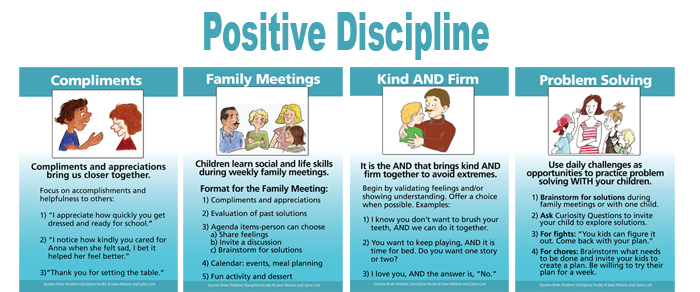Raising children comes with its challenges, and discipline is a significant part of parenting. Implementing effective parenting and discipline strategies is crucial for fostering a positive and supportive environment for your children. This blog will explore various discipline methods tailored to different ages and settings, ensuring you have the tools needed for success.
10 Parenting and Discipline Strategies in Child Care:

1. Positive Reinforcement:
- Reward good behavior with praise, attention, or small rewards to encourage repetition.
2. Redirection:
- Guide children towards appropriate activities to distract from undesirable behavior.
3. Time-Outs:
- Provide brief, calm periods for children to cool down and reflect on their actions.
4. Natural and Logical Consequences:
- Allow children to experience the natural outcomes of their behavior or apply related consequences to teach responsibility.
5. Consistent Routines:
- Establish clear daily routines to provide structure and stability.
6. Clear Communication:
- Use simple, direct language to explain rules and expectations.
7. Modeling Behavior:
- Demonstrate the behavior you expect from children through your actions.
8. Choices and Consequences:
- Offer children choices within set boundaries and explain the consequences of their decisions.
9. Problem-Solving Together:
- Involve children in finding solutions to behavioral issues to teach problem-solving skills.
10. Empathy and Understanding:
- Show empathy for children’s feelings and help them understand the impact of their actions.
Conscious Discipline Strategies:
Conscious discipline is a parenting approach that emphasizes connection, empathy, and problem-solving. It focuses on understanding your child’s behavior as a form of communication. Instead of punishment, it involves responding to your child’s needs with empathy and setting clear limits. This approach not only helps in addressing behavioral issues but also plays a crucial role in boosting parents confidence by providing effective tools to manage and guide their children’s behavior constructively.

Key principles of conscious discipline include:
- Active listening: Pay attention to your child’s feelings and needs.
- Setting limits with kindness: Establish clear boundaries with empathy.
- Natural and logical consequences: Allow your child to experience the consequences of their actions.
- Problem-solving together: Involve your child in finding solutions.
Positive Discipline Strategies:
Positive discipline focuses on building a strong relationship with your child while teaching life skills. It emphasizes encouragement, positive reinforcement, and natural consequences.

Effective positive discipline strategies include:
- Spending quality time: Build a strong bond with your child.
- Offering choices: Empower your child to make decisions.
- Using positive language: Focus on what you want your child to do.
- Teaching problem-solving skills: Equip your child with tools for life.
Zero Tolerance and Alternative Discipline Strategies:
Zero tolerance and alternative discipline strategies can be harsh and often ineffective. Instead, consider alternative discipline strategies that focus on rehabilitation and education. Approaches like restorative justice help children understand the consequences of their behavior and encourage them to make amends. For families managing remote work with kids, integrating these alternative strategies can provide a balanced approach that maintains a positive environment at home while addressing behavioral issues constructively.
Zero-tolerance policies often lead to negative outcomes. It’s essential to find alternative discipline strategies that address the root cause of behavior, especially in the context of balancing professional responsibilities with parenting.
Consider these alternatives:
- Time-in instead of time-out: Connect with your child during challenging moments.
- Restorative justice: Focus on repairing harm caused by the behavior.
- Positive behavior support: Identify and address the underlying reasons for challenging behavior.
Discipline Strategies for 3-Year-Olds:
Discipline strategies for 3-year-olds are crucial as they are at a stage where they are learning about boundaries and testing limits. Effective discipline strategies for this age include time-outs, redirection, and consistent routines. It’s essential to remain patient and provide clear and simple instructions to guide their behavior.
Discipline Strategies for 4-Year-Olds:
At four years old, children are more independent but still need guidance. Discipline strategies for 4-year-olds should include positive reinforcement, clear rules, and engaging in discussions about behavior. Encourage problem-solving and praise them for their efforts in making good choices.
Discipline Strategies for Toddlers and Preschoolers:
Discipline for young children requires patience, understanding, and consistency. Here are some effective strategies:
- Redirect their attention: Distract your child with an alternative activity.
- Use simple and clear language: Explain your expectations clearly.
- Offer choices: Give your child a sense of control.
- Be a role model: Demonstrate the behavior you expect.
Remember: Every child is unique. What works for one child may not work for another. It’s important to find discipline strategies that align with your child’s personality and temperament.
Discipline Strategies for Parents:
Parents need a toolbox of strategies to manage different situations effectively. Discipline strategies for parents include consistency, clear communication, and empathy. It’s also crucial for parents to model the behavior they want to see in their children. Engaging in parental involvement in academics can further enhance discipline strategies by creating a supportive environment for learning and development. This involvement ensures that parents are actively participating in their child’s education, reinforcing positive behavior both at home and in school.
Discipline Strategies in the Classroom:
Teachers face unique challenges in maintaining discipline in the classroom. Effective discipline strategies in the classroom include establishing rules early, fostering a positive classroom environment, and using collaborative problem-solving techniques. These methods help create a respectful and productive learning space.
How to discipline a child without yelling or hitting:
Effective discipline focuses on teaching, not punishing. Use positive reinforcement, clear expectations, and natural consequences. Build a strong bond with your child through quality time and empathy. Instead of yelling or hitting, try time-ins, active listening, and problem-solving together. Remember, patience and consistency are key to shaping good behavior.
Age-Appropriate Discipline Chart:
| Age | Discipline Strategies | Examples |
|---|---|---|
| 0-2 years | Redirection: Guide attention to appropriate activities. Simple Instructions: Use clear, straightforward language. Consistency: Establish predictable routines. | Distract a toddler with a toy if they’re reaching for something dangerous. Use “no touch” clearly and consistently. |
| 3-5 years | Time-Outs: Brief periods for reflection. Natural and Logical Consequences: Allow safe outcomes of behavior or apply related consequences. Positive Reinforcement: Praise and reward good behavior. | Remove a toy for hitting; praise for sharing. Let them experience mild discomfort if they refuse to wear a coat. |
| 6-8 years | Clear Rules and Expectations: Communicate and reinforce rules. Problem-Solving Together: Involve them in finding solutions. Logical Consequences: Related to the behavior. | Discuss consequences of not completing homework; help brainstorm solutions. Loss of screen time for not following rules. |
| 9-12 years | Consistent Routines: Maintain stability and structure. Encouragement and Rewards: Use positive reinforcement for good behavior. Natural and Logical Consequences: Allow or impose related outcomes. | Enforce chores and responsibilities; reward good grades. Missing out on a fun activity if chores are not done. |
| 13-18 years | Respectful Communication: Engage in discussions about behavior. Negotiated Consequences: Allow input on consequences. Encouragement of Independence: Support self-regulation and problem-solving. | Discuss and agree on consequences for missing curfew. Encourage setting and following personal goals. |
This chart provides a general guideline for age-appropriate discipline strategies, focusing on encouraging positive behavior and fostering responsibility at different developmental stages.
Conclusion:
Implementing effective parenting and discipline strategies is essential for fostering a nurturing and supportive environment for children. By utilizing conscious discipline strategies, parents can create strong emotional connections with their children, helping them develop self-regulation and problem-solving skills. Positive discipline strategies reinforce good behavior through encouragement and natural consequences, building a positive relationship between parent and child.
FAQS:
Q: Provide me Parenting and Discipline Strategies?
Parenting and discipline strategies should be flexible to adapt to the needs of each child. Combining various methods such as conscious, positive, and alternative discipline strategies can provide a balanced approach to managing behavior.
Q: What are the discipline approaches in parenting?
A: Discipline approaches in parenting include positive discipline, authoritative parenting, time-outs, natural and logical consequences, conscious discipline, and gentle parenting. Each approach emphasizes different methods to guide and correct children’s behavior while fostering a supportive and nurturing environment.
Q: What tends to be the most effective discipline strategies at the ages 3 to 5?
A: For children aged 3 to 5, effective discipline strategies include consistent routines, clear and simple instructions, positive reinforcement, time-outs, and redirection. These strategies help children understand boundaries, encourage good behavior, and manage their emotions and actions.
Q: How do discipline methods change and evolve for each age group?
A: Discipline methods evolve as children grow and their cognitive and emotional abilities develop. For toddlers, simple instructions and redirection are key. Preschoolers benefit from clear rules and positive reinforcement. As children enter school age, logical consequences and collaborative problem-solving become more effective. Teenagers require more autonomy and discussion-based approaches to discipline.
Q: What is the most effective form of discipline for children?
A: The most effective form of discipline for children is a combination of positive reinforcement, setting clear boundaries, and using natural and logical consequences. This balanced approach encourages good behavior, teaches responsibility, and fosters a healthy parent-child relationship by focusing on communication and mutual respect.
Q: How to be disciplined?
A: Being disciplined involves setting clear goals, creating a routine, and sticking to it. It requires consistency and commitment, even when motivation wanes. Start small and gradually build more challenging tasks into your routine.
Q: How to build discipline?
A: Building discipline starts with setting specific, achievable goals. Break tasks into manageable steps, establish a consistent schedule, and hold yourself accountable. Use tools like planners or apps to track your progress and stay organized.
Q: What is self-discipline?
A: Self-discipline is the ability to control one’s emotions, behaviors, and desires in the face of external demands, to achieve long-term goals. It involves willpower, persistence, and the ability to delay gratification.
Q: How to be more disciplined?
A: To be more disciplined, identify your priorities and eliminate distractions. Develop a strong work ethic, practice self-control, and reward yourself for meeting your goals. Regularly review and adjust your strategies to stay on track.
Q: How to have self-control?
A: Building self-control involves practicing mindfulness, setting clear boundaries, and developing healthy habits. Avoid temptations by changing your environment and use positive reinforcement to encourage desired behaviors.
Q: Is spanking effective?
A: Spanking is generally not considered effective and can have negative long-term effects on children. It can lead to increased aggression, antisocial behavior, and mental health issues. Positive discipline strategies are recommended.
Q: How to get discipline?
A: To gain discipline, start with small, manageable tasks and gradually increase their complexity. Establish a daily routine, stay committed to your goals, and seek support from friends, family, or mentors.
Q: How to gain self-control?
A: Gaining self-control involves understanding your triggers, practicing mindfulness, and developing coping strategies. Use positive reinforcement to reward self-controlled behavior and gradually increase your ability to resist temptations.
Q: How to become self-disciplined?
A: Becoming self-disciplined requires a commitment to personal growth and consistency in your actions. Establish a clear vision of your goals, break them into smaller tasks, and maintain a structured daily routine. Seek accountability from others to stay on track.
Q: What is the Best Punishment for a Child?
Punishment isn’t the best approach. Focus on positive discipline: clear expectations, natural consequences, and teaching responsibility. Building a strong relationship through praise and quality time is more effective than punishment in shaping good behavior.
External Resources:
CDC – Essentials for Parenting Toddlers and Preschoolers
The Centers for Disease Control and Prevention offers practical tips on how to discipline children positively.
Harvard University – Center on the Developing Child This resource offers insights into child development, including strategies for discipline and behavior management.
Parenting for Lifelong Health – Positive Discipline
This WHO initiative provides resources for implementing positive discipline strategies in different cultural contexts.

Empowering parents to raise happy, confident kids. Get practical parenting tips and advice on our blog, Smart Parent Guides.
